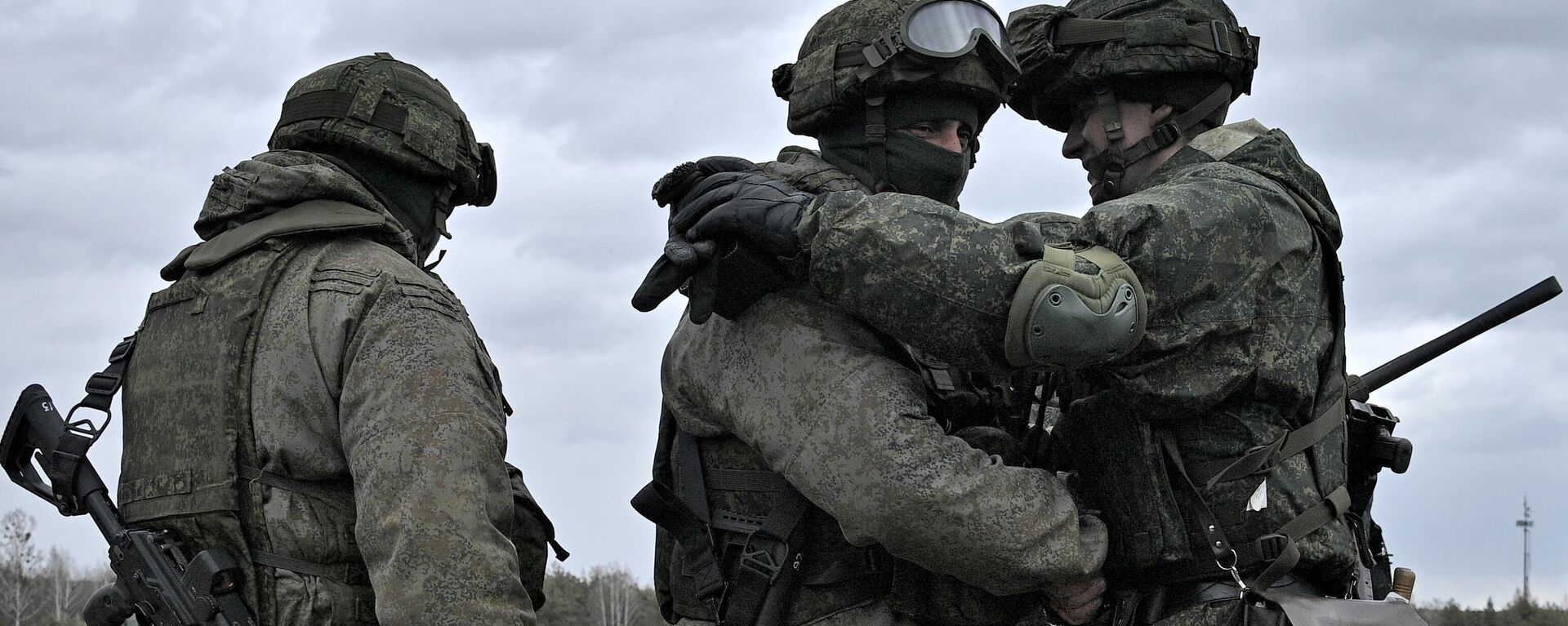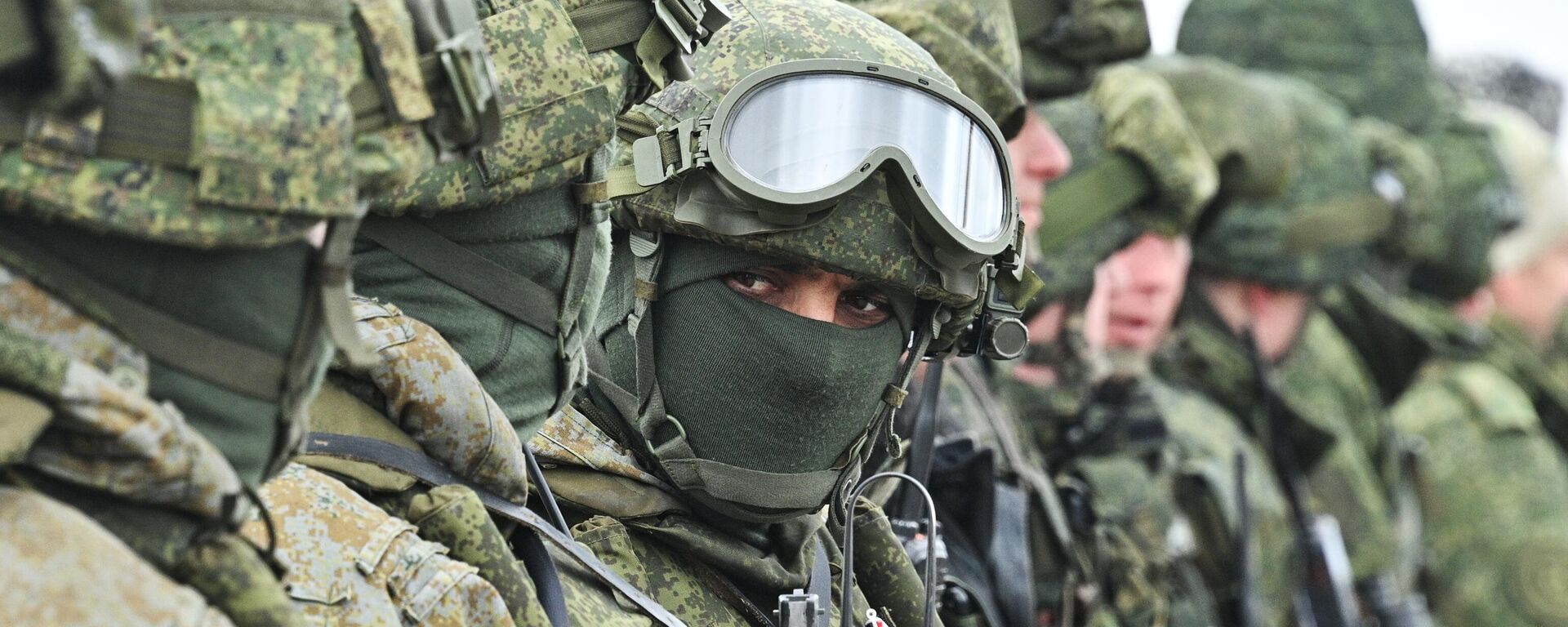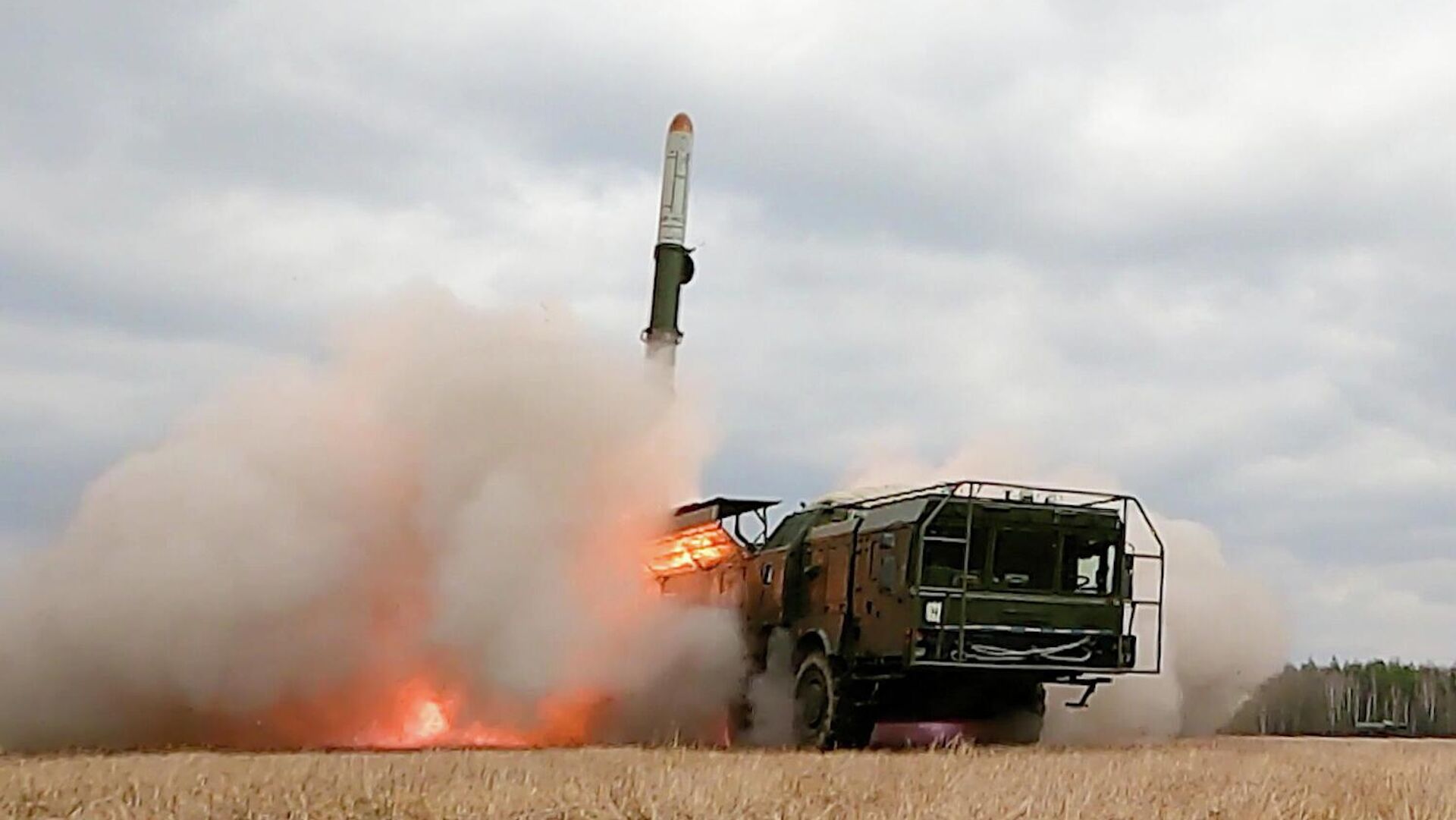https://sputnikglobe.com/20240426/how-russian-nuclear-umbrella-shields-belarus-from-nato-and-minions-1118130566.html
How Russian Nuclear Umbrella Shields Belarus From NATO and Minions
How Russian Nuclear Umbrella Shields Belarus From NATO and Minions
Sputnik International
Minsk is concerned about emerging security threats while Belarus' new military doctrine describes the deployment of Russian nuclear weapons as key to strategic deterrence amid growing geopolitical instability.
2024-04-26T18:49+0000
2024-04-26T18:49+0000
2024-04-26T18:49+0000
belarus
alexander lukashenko
lithuania
russia
nato
union state
military
collective security treaty organization (csto)
nato expansion
opinion
https://cdn1.img.sputnikglobe.com/img/07e6/05/04/1095255381_0:213:1496:1056_1920x0_80_0_0_73ad729725a0601f29d8034ad48c2486.jpg
The All-Belarusian People's Assembly (APA) unanimously adopted a new military doctrine on April 25, while the National Assembly passed the country's updated National Security Concept. The documents set the goal of boosting national security in coordination with the Union State of Russia and Belarus, as well as the Collective Security Treaty Organization (CSTO) and the CIS. The nation's military strategy ensures security through conflict prevention and guaranteed defense and sees the deployment of Russia's tactical nuclear weapons on its territory as a viable tool of deterrence.Stefanovich drew attention to NATO's steady military build-up on the bloc's eastern flank with the rapid militarization of Poland. Under these circumstances the deployment of Russia's tactical nuclear weapons is a step in the right direction in terms of creating deterrence, the scholar emphasized.Addressing the gathering on April 25, Belarusian President Alexander Lukashenko warned that in the event of an attack, the aggressor would see an instant response with all types of weapons from both Minsk and Moscow."Today we are fully determined to resist any aggressor and inflict unacceptable damage on them," Lukashenko told the All-Belarusian People's Assembly.In 2009, Moscow and Minsk signed an agreement on the joint protection of the airspace borders of the Union State, as well as the establishment of the united regional air defense system. In 2022, a joint Russian-Belarussian military contingent was deployed in the Eastern European state to deter potential threats from the direction of Poland and Ukraine. In 2023 Moscow and Minsk agreed on the deployment of Russian tactical nuclear weapons in Belarus with Russia also providing its ally with nuclear-capable Iskander tactical ballistic missile systems.How Serious Are Threats on Belarus' Ukraine and Lithuania Borders?While delivering his speech on Thursday, Lukashenko also referred to the risk of military incidents at the Belarusian border with Ukraine. For his part, Ivan Tertel, head of the Belarusian Committee for State Security (KGB), revealed to the All-Belarusian People’s Assembly that the nation's military had prevented attempted drone strikes from Lithuania targeting Minsk and its neighborhoods.Risks at the Ukrainian-Belarusian border appear to be higher in comparison with a potential challenge posed by Lithuania, according to Yuriy Shevtsov, a political analyst and director of the Belarusian Center for Problems of European Integration.He explained that the Belarus-Lithuania border is approximately 720 kilometers long, whereas the nation's border with Ukraine stretches for over 1,000 kilometers. In terms of military force, there are around 120,000 Ukrainian troops amassed near the border with Belarus while Lithuania may have roughly 18,000 military soldiers at its mutual border with Belarus, Shevtsov presumed.Shevtsov downplayed Vilnius's efforts to fortify its border with Belarus, suggesting that it appears to be a PR stunt in the first place. Meanwhile, the reported drone strike, which Lithuania has denied, was aimed at testing the Belarusian air defense systems which are quite advanced, as per Sputnik's interlocutor.He warned, however, that Lithuania could potentially target the Astravec Nuclear Power Plant located in the Astravyets district of Grodno region in north-western Belarus. Shevtsov noted, however, that the atomic plant is well-covered by air defenses. Apart from Astravec, the city of Grodno, which is located at the junction of the borders with Lithuania and Poland, could also be targeted with some sort of a minor strike, the expert observed.
https://sputnikglobe.com/20240426/minsk-opposes-nato-expansion-ready-for-pragmatic-dialogue---military-doctrine-1118122942.html
https://sputnikglobe.com/20231213/how-deep-does-russia-belarus-military-cooperation-go-1115557014.html
https://sputnikglobe.com/20240222/west-doubles-military-presence-on-belarus-russia-borders-since-2020---belarus-minister-1116925064.html
belarus
lithuania
russia
Sputnik International
feedback@sputniknews.com
+74956456601
MIA „Rossiya Segodnya“
2024
News
en_EN
Sputnik International
feedback@sputniknews.com
+74956456601
MIA „Rossiya Segodnya“
Sputnik International
feedback@sputniknews.com
+74956456601
MIA „Rossiya Segodnya“
belarusian new military doctrine, belarus uses nuclear weapons as startegic deterrence, nato expansion, nato eastward expansion, nato's military buildup on its eastern flank, the union state of russia and belarus, russia ensures belarus security, belarus' defense doctrine, belarusian national security concept, russia deployed nuclear-capable iskanders in belarus
belarusian new military doctrine, belarus uses nuclear weapons as startegic deterrence, nato expansion, nato eastward expansion, nato's military buildup on its eastern flank, the union state of russia and belarus, russia ensures belarus security, belarus' defense doctrine, belarusian national security concept, russia deployed nuclear-capable iskanders in belarus
How Russian Nuclear Umbrella Shields Belarus From NATO and Minions
Minsk is concerned about emerging security threats while Belarus' new military doctrine describes the deployment of Russian nuclear weapons as key to strategic deterrence amid growing geopolitical instability.
The All-Belarusian People's Assembly (APA) unanimously adopted a new military doctrine on April 25, while the National Assembly passed the country's updated National Security Concept.
The documents set the goal of boosting national security in coordination with the Union State of Russia and Belarus, as well as the Collective Security Treaty Organization (CSTO) and the CIS. The nation's military strategy
ensures security through conflict prevention and guaranteed defense and sees the deployment of Russia's tactical nuclear weapons on its territory as a viable tool of deterrence.
"There is certainly a threat [to Belarus from the West]," Dmitry Stefanovich of the Moscow-based Institute of World Economy and International Relations with the Russian Academy of Sciences told Sputnik. "The military doctrine very clearly states that this threat is multi-faceted. It addresses not only some sort of a potential military confrontation but also attempts [by external players] to launch negative destabilization processes within the country."
Stefanovich drew attention to NATO's steady military build-up on the bloc's eastern flank with the rapid militarization of Poland. Under these circumstances the deployment of Russia's tactical nuclear weapons is a step in the right direction in terms of creating deterrence, the scholar emphasized.
"This is a symbol that Russia is fully extending its nuclear umbrella to Belarus," the expert said. "And that an armed conflict in Belarus cannot but involve Russia as a guarantor. [Russia and Belarus] have a single defense contour of the Union State, which is multi-faceted, including the nuclear sphere."
Addressing the gathering on April 25, Belarusian President Alexander Lukashenko warned that in the event of an attack, the aggressor would see an instant response with all types of weapons from both Minsk and Moscow.
"Today we are fully determined to resist any aggressor and inflict unacceptable damage on them," Lukashenko told the All-Belarusian People's Assembly.
In 2009,
Moscow and Minsk signed an agreement on the joint protection of
the airspace borders of the Union State, as well as the establishment of the united regional air defense system. In 2022, a joint Russian-Belarussian military contingent was deployed in the Eastern European state to deter potential threats from the direction of Poland and Ukraine. In 2023 Moscow and Minsk agreed on the deployment of Russian tactical nuclear weapons in Belarus with Russia also providing its ally with nuclear-capable Iskander tactical ballistic missile systems.
"Active programs for [Belarusian military] rearmament, increased combat readiness, etc., have been launched with the direct participation of Russia," Stefanovich stressed. "That is, several years ago the so-called joint combat training centers were formed. More modern weapons are gradually entering into service."

13 December 2023, 14:41 GMT
How Serious Are Threats on Belarus' Ukraine and Lithuania Borders?
While delivering his speech on Thursday, Lukashenko also referred to the risk of military incidents at the Belarusian border with Ukraine.
For his part, Ivan Tertel, head of the Belarusian Committee for State Security (KGB), revealed to the All-Belarusian People’s Assembly that the nation's military had prevented attempted drone strikes from Lithuania targeting Minsk and its neighborhoods.
Risks at the Ukrainian-Belarusian border appear to be higher in comparison with a potential challenge posed by Lithuania, according to Yuriy Shevtsov, a political analyst and director of the Belarusian Center for Problems of European Integration.
He explained that the Belarus-Lithuania border is approximately 720 kilometers long, whereas the nation's border with Ukraine stretches for over 1,000 kilometers. In terms of military force, there are around 120,000 Ukrainian troops amassed near the border with Belarus while Lithuania may have roughly 18,000 military soldiers at its mutual border with Belarus, Shevtsov presumed.
"There is no military threat from Lithuania specifically," the expert said. "However, there are troops of different NATO member states deployed in the country."
Shevtsov downplayed Vilnius's efforts to fortify its border with Belarus, suggesting that it appears to be a PR stunt in the first place. Meanwhile, the reported drone strike, which Lithuania has denied, was aimed at testing the Belarusian air defense systems which are quite advanced, as per Sputnik's interlocutor.
He warned, however, that Lithuania could potentially target the Astravec Nuclear Power Plant located in the Astravyets district of Grodno region in north-western Belarus. Shevtsov noted, however, that the atomic plant is well-covered by air defenses. Apart from Astravec, the city of Grodno, which is located at the junction of the borders with Lithuania and Poland, could also be targeted with some sort of a minor strike, the expert observed.
"Right now I wouldn’t consider this as a real threat. If there were no Russian tactical nuclear weapons in Belarus, there could be grounds for concerns. But since they exist and they are to a large extent in Belarusian hands, this means that Belarus is unlikely to face a big blow from NATO. And a small blow, if it is delivered by Lithuania or by the Belarusian oppositionists under the guise of Lithuania, would be easily repelled by the Belarusian Army," the analyst concluded.

22 February 2024, 15:43 GMT





